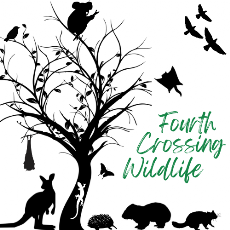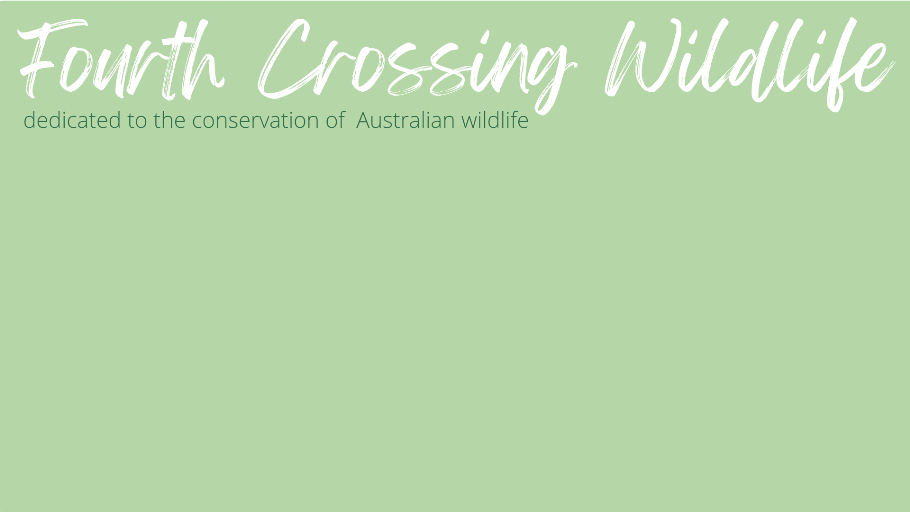Stories
Saving the Northern Hairy-nosed Wombats
by Linda Dennis
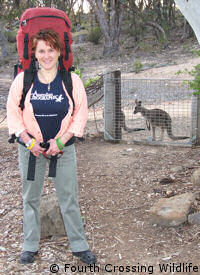 Leaving Fourth Crossing for Epping Forest complete with macropod farewell 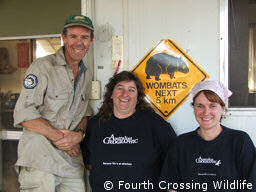 Alan Horsup, Carol Pullar and me at Epping Forest 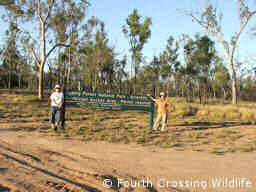 Therese Black and me at the entrance of Epping Forest 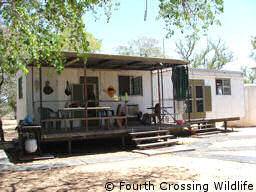 Epping Forest base camp 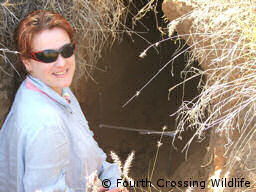 Tagging my first burrow 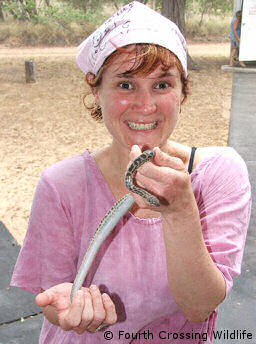 Meeting the local wildlife 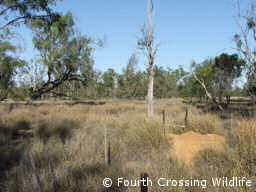 Burrow 44 in the area called Wild Horse 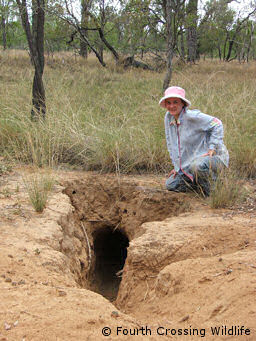 Me at at burrow 172 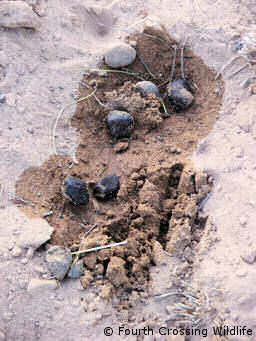 Recent wombat activity, probably by a male (male wombats scratch the ground after defecating) 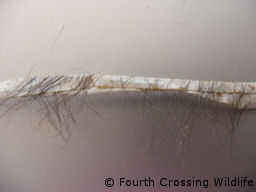 Wombat hairs on the double sided sticky tape 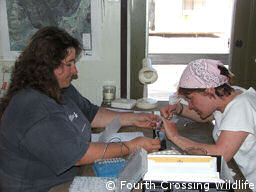 Carol Pullar and me working in the lab cutting off individual hairs from the tape 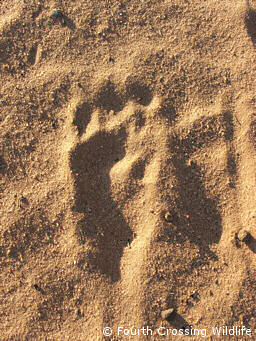 Wombat footprint in the sandy soils of Epping 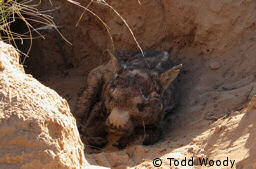 Saggy Baggy Wombat, the old girl of Epping 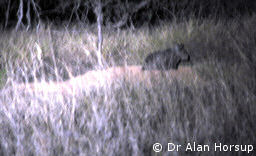 Our "spotlight wombat" 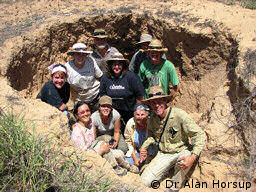 The 2007 Hair Census Team from front right, clockwise Alan Horsup (in hat), Hazel Hanrahan, Hilary MacDonald, Therese Black, Linda Dennis, Helen Matthews, Dennis Hanrahan, Carol Pullar, Roberto Munguia and Todd Woody | PLEASE NOTE : this story was written in 2007 and shows the statistics of the NHNW at that time. Read through and enjoy the story knowing that the statistics have now changed. At the end of the story are the updated figures as at 2022. Wombats have been a fascination for Carol Pullar and me for many years - one could even say an all consuming passion! We're both specialist carers for Bare-nosed Wombats needing rehabilitation and recuperation. Carol conducts her rehabilitation work at her Wildlife Shelter in Victoria and I own a Wildlife Refuge in the central west of NSW, known to many as Fourth Crossing Wildlife. So, with wombats having a major appeal to both of us, when we heard that volunteers were needed to conduct a Hair Census on the critically endangered Northern Hairy-nosed Wombat in remote central Queensland, we jumped, stomped and danced at the chance to be involved. The Northern Hairy-nosed Wombat is one of Australia's most endangered animals. In fact, they have the dubious honour of making it to the top ten in the worlds' most endangered animals list. What makes the wombats conservation status even more vulnerable is that there are only 115 individuals (see update) and all live in the one location - Epping Forest National Park, which is about 120km's north west of the small township of Clermont in Queensland. There are no Northern Hairy-nosed Wombats in captivity, nor are they found anywhere else in the wild (see update). The Queensland Parks and Wildlife Service have been working tirelessly with the aim to save the species from extinction. Every now and then however, there is a need for volunteers to help with the project - and that is where Carol and I come into this wombat story. After being accepted as volunteers to the project Carol and I decided to approach the Australian Society for sponsorship. AusGeo had given generously to the project in previous years and we were unsure if our request for help would be answered. To our delight we were granted the much coveted sponsorship and our wombat story got even better! Every two years or so a Hair Census is needed to ascertain just how many wombats there are, what their movements are over the park and most importantly, if there are wombat joeys being born. The 2007 census had even more significance as the findings would be the determining factor in any future translocation - moving individuals off the park into a new location to further protect the species from decline (see update). The Hair Census Team consisted of ten individuals - all volunteers to the project. It was heartening to see that the plight of the Northern Hairy-nosed Wombat had reached an international audience as there were several countries in attendance; Todd Woody from the US, Roberto Munguia from Mexico and Hilary MacDonald from Canada. Queensland also made a great show; there was Helen Matthews and Caitlin Palmer-Bright from Brisbane, Therese Black from the Sunshine Coast and Hazel and Dennis Hanrahan from Hervey Bay, who were also the live-in caretakers for the month of October. Then, of course, there was me from NSW, Carol from Victoria. Our adventure started in Rockhampton where the project head quarters are located. Several of us met at the pub and spent an evening together full of excitement and nerves as we discussed our upcoming journey to what we knew as "the middle of nowhere". Only one of us, Helen, had been to Epping Forest before and she was plied with all kinds of questions as to what we could expect. Early the next morning we started our long trip to Epping Forest. It would take us eight hours in a convoy of two four wheel drives to get there. At the township of Emerald we stopped to purchase two weeks worth of food, and after a quick lunch we were back on the road with one more stop at Clermont to buy wombat food and reaching Epping Forest just before dusk. After an excitable dinner - we were finally here!! - we had our first briefing from Alan Horsup (team leader), a run down on what was expected of us during the 11 day census. The work sounded quite challenging but definitely "do-able" and it was early to bed as we had to be up before dawn the next morning. The first day was tough. Up at 4.30am for a quick breakfast and out in the field by 5.15am. There was good reasoning for the early start - the heat! The day packed a punch - 37 degrees Celsius in the shade but also incredibly humid as storms hovered over us. We were buddied into teams of two and each team were given a set route through the park, which we would then work every day during the census. Day one was the most physically challenging for all of us. Armed with sets of heavy metal stakes we walked our allocated terrain, stopping at each burrow and setting the hair traps. Some burrows had fences built around them and these were relatively easy to trap as we placed the double sided sticky tape (which collected the hair for the census) on the gates which were at intervals around the fences. The burrows without fences had to be manually staked, so each of us had to also lug around a heavy mallet to hammer the stakes into place. At lunch time we headed back to camp and for the two hottest hours of the day we rested under the shade of the kitchen verandah. Mid afternoon we were back at work until dusk when we breathed a sigh of relief, pondered a good days work and cooled off with a well earned cold beer. After a mentally and physically draining day, Alan decided to give us some time out on day two. We took the morning to rest and to compare notes from the day before - who had seen a wombat footprint, who had recognised wombat poo and who had the hardest run of all! After lunch we headed out again to finish trapping the burrows. The third day was the first day of hair collecting, although it was a trial day so we could get the hang of recognising and collecting wombat hair before the official collection began. Much to our annoyance many of the hair samples left on the double sided sticky tape were from the many Swamp Wallabies that also call Epping Forest home. Wombat burrows also make a cool retreat for the wallabies during the hottest times of the day. It was back breaking work, especially for those of us who had come from cooler southern climates into the full northern heat. At times in the first few days I didn't think I'd make it to the end of the census. As the days moved on however, working in the Queensland outback heat become more bearable. We all acclimatised, but thankfully the temperature also fell to the milder lower 30's. Each afternoon we would make our way back to camp with a back pack full of hair. We had some friendly competitions going; who found the most Swamp Wallaby hairs; who found the most wombat hairs (the ultimate winner of course); and who found the most unusual sample. I believe I found that - I came across a tape that had obviously been chewed on. I could just picture a lazy wombat lying at the entrance of her burrow and chewing on the annoying white thing that kept ripping hair out of her rump! That piece of tape is now one of my prized possessions! After lunch and a daily siesta during the hottest time of the day (making Roberto feel like he was back home in Mexico) the afternoons were for lab work, where teams of two processed the daily hair take. One member of the team would hold the sticky tape out for the other team member - who with very good eyes carefully cut individual hairs off the tape - 180 individual hairs a day! We had to ensure that the follicle was left in tact, as it is the follicle that contains the precious wombat DNA. The minute piece of hair (about 2mm in length) would then be placed into a labelled Eppendorf (tiny plastic test tube) and then boiled in water for 10 minutes. The boiling resulted in the DNA of the wombat being infused in the fluid called Chelex that was inside the Eppendorf - the Chelex would later be tested at Monash University to read the DNA and to ascertain the population count. The trip wasn't all hard work. We had some great evenings full of lively chit chat about our home towns, our hobbies, our friends and family, etc, and we listened to music from the several MP3 players that also made the journey to Epping Forest. The late afternoons were also "our" time and we sometimes walked through the park, taking the cooler temperatures to our advantage, viewing the rugged beauty of the area and breathing the clean, fresh air. One very special afternoon, late in the trip, Therese, Hazel and I went for short walk up the Hairy-nosed Highway (the main dirt road that runs the length of the park). Venturing back just on dusk we were rewarded with our first ever Northern Hairy-nosed Wombat sighting - a young wombat trotted across our path and back into its burrow. It was one of the most awesome events in all of our lives!! We rushed back to camp, did a happy dance around the camp fire, and excitedly told the others of our lucky find. In seconds we'd joined an elite group - we were three of only 500 odd people in the entire world to have seen a Northern Hairy-nosed Wombat in the wild! Night time walks were not allowed during the census as human presence around the burrows could disturb the wombats normal nightly activity and the census results may have been skewed. However, on our very last night at Epping Forest, with the hair census complete and the samples catalogued and ready in the freezer, Alan rewarded us with a spot light tour. After dinner we set out full of anticipation, excitement and nerves. We very slowly travelled the length of the park, three spotlights arching across the dark and still night. To our major delight we were honoured with the presence of three wombats during the couple of hours we were out. Every volunteer had the very special privilege of seeing a Northern Hairy-nosed Wombat in the wild - a fitting end to our trip and a wonderful reward for all our hard work. We returned to camp and opened a bottle or two of champaign to celebrate. The Northern Hairy-nosed Wombats needs your help. The project receives very little funding from government authorities and saving this species very much relies on the generous donations from the public. Knowing that donations were desperately needed, Carol and I discussed how to use our AusGeo sponsorship to its best advantage - we very much wanted to donate to the project, to put the money where it was needed most. Initially we had thought to provide the project with money to buy one or two monitoring collars. However, in the end, we decided to donate a major portion of our sponsorship to the project to help purchase a set of scales that will be installed at a feeding station. Once the scales are installed, when the wombats come in to feed they will be weighed at the same time ruling out the need for human contact. In the past wombats were captured to be weighed, which is very distressing to a wild wombat. With the help of AusGeo it was money very well spent. The species is one of Australia's most vulnerable - 115 in one location…. make that 114 (see update). Mid way through our trip Todd came across Saggy Baggy Wombat, an old wombat near the end of her life. Out walking one afternoon Todd found Saggy Baggy at the entrance of her burrow, we think soaking up the suns warmth on her skin and bone body. We set up camera equipment at the entrance of her burrow so that she could be monitored and we also set up a feed and water station close by. During the subsequent days we watched on film the Old Girl of Epping shuffle around her burrow and eat and drink what we had offered. She was so skinny and much of her fur had fallen out and we felt good that she once again had a full tummy and we hoped that she was content. Two days after returning home Hazel and Dennis emailed us all to advise that Saggy Baggy Wombat had died. Her death well and truly brought it home just how vulnerable the species is and just how desperately they need our help to survive. Although very sad, we saw the death of Saggy Baggy Wombat not as an end but as a cycle of life. It is too soon to tell what kind of new numbers we're looking at for the species, but based on the increased activity of the 2007 Hair Census compared to the last census we're hoping that there are lots wombat joeys running around Epping Forest, and maybe one of them will move into Saggy Baggy's now empty burrow. The two weeks I spent at Epping Forest were hot, dirty and bloody hard work, but they were two of the best weeks of my life. Carol and I - and the other volunteers - got to do our bit to help save the Northern Hairy-nosed Wombats. I urge any one of you who has read this story and now feels that tingle of eagerness to be involved to jump right in there - you will be rewarded with an achievement that you will certainly feel proud of! 2022 UPDATE There are now two seperate locations for the Northern Hairy-nosed Wombat - Epping Forest National Park and the new translocation site - Richard Underwood Nature Reserve (RUNR) near St George in Queensland. In December 2009, five Northern Hairy-nosed Wombats were trapped at Epping Forest National Park and translocated to RUNR. In 2010, another trapping at Epping resulted in the capture of 10 (two males and eight females) wombats suitable for translocation to RUNR. These wombats were transported to RUNR the next day and released to join the five wombats released the previous year. The population at RUNR has since grown with young being born. The Wombat Foundation is currently searching for a third translocation site. The current statistics show that there are 315 individuals living across the two sites (in the early 80's there were only an estimated 35 individuals and the 2007 census resulted in 115 individuals). The most recent hair census was conducted in September 2022, results are pending. Photos below are from the first translocation. All photos are by Todd Woody, environmental journalist, who was at Epping Forest for the translocation (lucky Todd!). 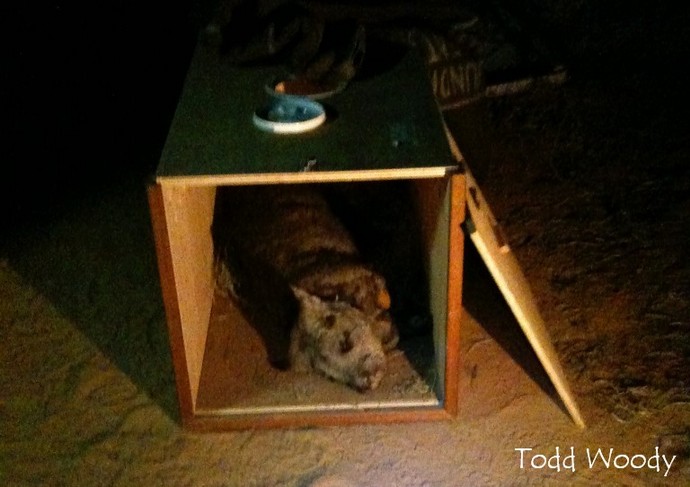 "Neil" was the first wombat to be translocated to Richard Underwood Nature Reserve on July 20 2009, on the 40th anniversary of the moon landing. 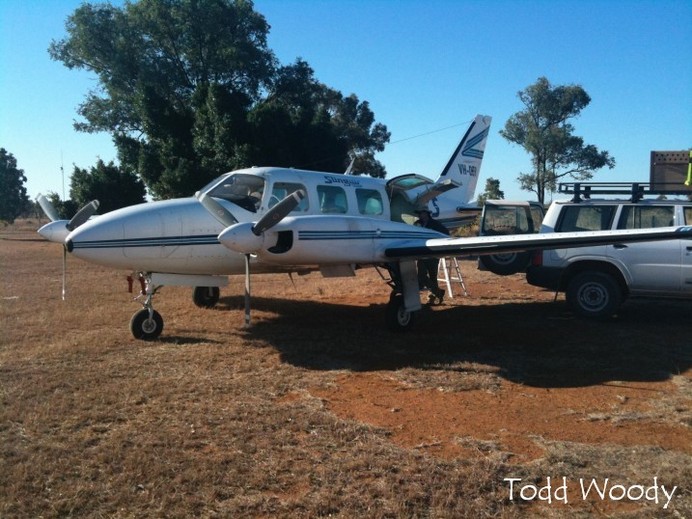 The Wombat Express 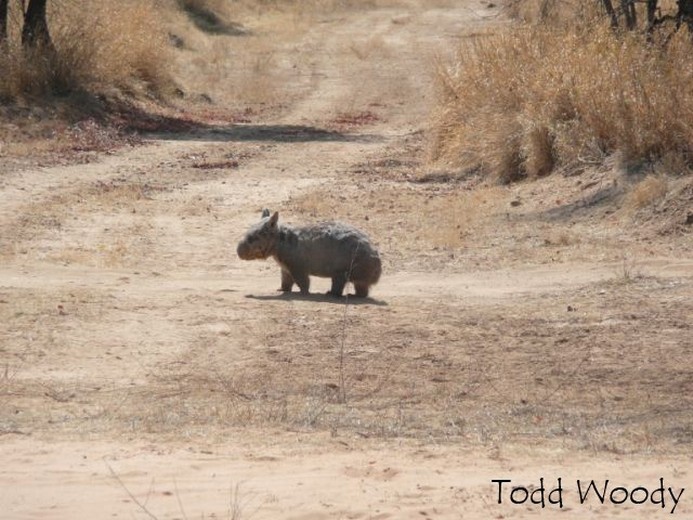 One of the translocated wombats at Richard Underwood Nature Reserve External links : |
